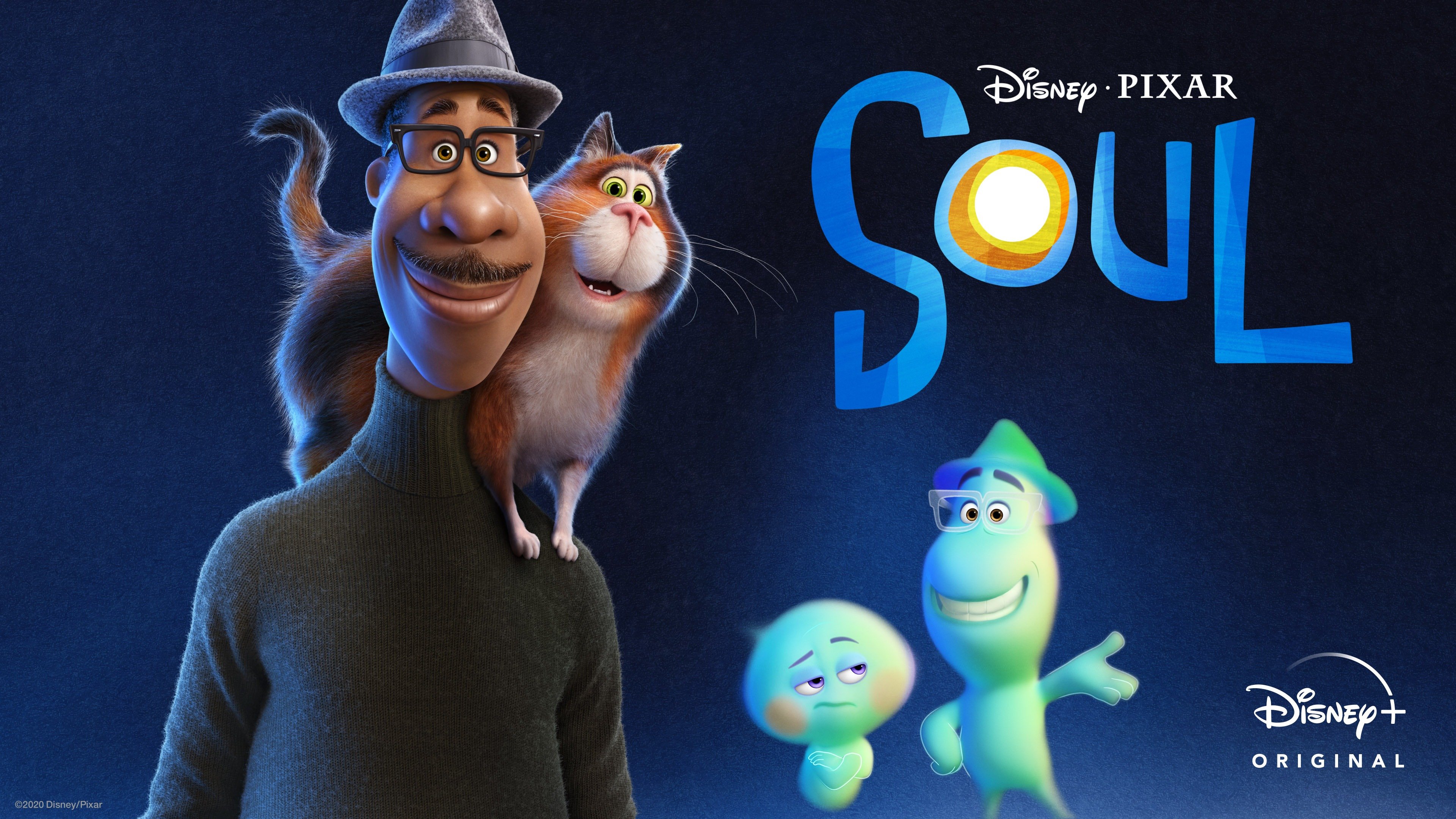 |
| Photo courtesy of Rotten Tomatoes. And yes, the cat is important. |
Pixar seems to be an existential roll lately. The studio got its start wondering what life would be like for toys when we humans aren’t looking (Toy Story), and then moved on to what it’s like living in an ant colony (A Bug’s Life), all the way up to what a society made up of living cars would be like (uh…Cars). But it seems like Pixar has been more interested in death; Coco (2017) featured a 12-year-old Mexican boy accidentally going to the Land of the Dead to learn about his family’s hatred of music, while Onward (2020) had two elf brothers rediscover magic so they could have one day to spend their father, who died before they really knew him. And Soul, released exclusively to Disney+, looks to be continuing that trend in a powerfully heartwarming way.
The film opens with the classic Disney castle and Wish Upon a Star being played…rather poorly by a middle-school band class in New York City. Said class is being taught by one Joe Gardener (Pixar’s first African American lead character who is voiced by Jamie Foxx), who tries to instill a love of music into his students through a beautiful jazz solo on his piano with less-than-stellar results. Joe is left feeling unfulfilled with his stable but stupefying job, but a chance call from one of his old students gives him a chance at playing with one of his idols. Of course, in his joy of finally fulfilling his dreams, he falls down an open manhole and his soul winds up in the Great Beyond, before he winds up falling into yet another section of the afterlife occupied by “Jerries,” astral (and traditionally animated) beings who are devoted to helping new souls find their “spark” before those souls go to Earth to inhabit newborn bodies. He meets up with 22 (voiced by Tina Fey), a cynical and sarcastic soul who absolutely refuses to find her spark and go to Earth, and together they work to find a way for Joe to get back to Earth so he can live out his dream.
For a movie whose plot kickstarts with the character dying, Soul is actually a lot more interested in the living. As a whole, the story focuses on answering a single question: What really satisfies the soul? Joe starts his story fixated on fulfilling his passions (something that most people would argue is supposed to be satisfying), while 22 possess no real passion to go to Earth. But as the two work together to get Joe back, they encounter a variety of different characters, both living and otherwise, that challenge both to rethink their notions of what it means to truly be alive and what really pleases the soul. The story never favors one main character over the other but instead gives equal focus and development to both. It is a story filled with much of the typical wacky yet delightful Pixar humor, but it’s also a tale that asks us and the characters to look harder at the little things that surround us and realize the beauty that can be found in them.
| Photo courtesy of Rotten Tomatoes. |
Of course, no discussion about a film with soul music would be complete if it ignored the sense of hearing, and Soul is a treat for the ears as well as the eyes. Most of the soundtrack, like the film itself, is divided between the jazz beats on earth and the more heavenly-sounding music of the Great Before. The Great Before music is, most shockingly, composed by Trent Reznor of industrial metal band Nine Inch Nails, but the soft, ambient tones are very effective in creating a calming and welcoming atmosphere to this afterlife. And the earthly jazz tunes are not to be ignored, either; whether jazz is your jam or not, you will find yourself tapping your foot to every little sound that a musician plays (mostly Joe at his piano) and may even take you along to the zone as well. Soul is a film that does right by its musical inspiration (as highlighted by its recent Golden Globe win for Best Original Score).
Leading the charge on this whole is the charming voice-acting for Joe and 22. Jaime Foxx and Tina Fey both have a great comedy duo routine with Foxx playing the friendly but anxious straight man to Fey’s impish wise guy (er, girl. Sort of). Fey does a great job providing the laughs with her trademark snarkiness while also giving 22 some sensitive moments, and Foxx keeps Joe charming and likable even when his passion for jazz can him a bit insensitive. They are also bolstered by an array of performances featuring everyone from Graham Norton as a quasi-shamanic soul named Moonwind to Angela Basset as Dorothea Williams, one of Joe’s jazz idols.
Pixar has a well-earned reputation for looking at the lives of things that tend to go unnoticed by people going about their day. And while Soul does invite us to think about the afterlife (something that nobody has allegedly seen), it also asks us to think about—and look at—life around us. Boasting wonderful visuals, beautiful music, and charming characters, Soul makes a strong case that our best life might just be the one we’re living now.
Final rating: 10 stars out of 10. Director: Pete Docter. Screenplay: Pete Docter, Mike Jones, and Kemp Powers. Starring: Jamie Foxx, Tina Fey, Graham Norton, Rachel House, and Angela Basset.